EMERGING INDIA : YOUNG CONTEMPORARIES - By Parul Dave Mukherjee with contributions from Giridhar Khasnis & Nandini Ghosh
If defining the contemporary is no longer the prerogative of the west in our post colonial and increasingly post nationalist present, the different takes on the contemporary become a central issue today. Much as we have come to distrust the binary logic in our postmodern era, placing contemporary Indian art in relation to trends in the west inevitably entails comparativism of sorts. If in the west, apocalyptic imagination about the end of art and art history periodically asserts itself; the Indian cultural scene envisions dreams of renewal and regeneration.
Contemporary Indian art had come of age decades ago but it is only now that it has caught global attention. With art galleries and auction houses the world over registering a strong Indian presence; the forthcoming exhibition of contemporary Indian art at the RCA is timely and topical. What in the late 1980s was a faint signal in this direction when Hayward Gallery in London had mounted an ambitious show titled The Other Stories, has blossomed into a vibrant phenomenon in the international arena.

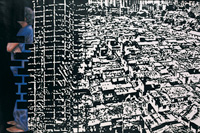
Today, there is no dearth of art exhibitions on contemporary Indian art in London, quite in sync with the boom in the art market in the subcontinent. With globalization impacting peoples’ lives and life styles in unimaginable ways, when traveling across the national borders has become a common occurrence, more and more number of people is encountering different cultures in their daily lives. This has given rise to cultural eclecticism when visual taste that manifests both in art practice, art viewing and art collecting has grown diverse.
What marks this exhibition at the RCA exceptional is that it will showcase for the first time emerging trends in the Indian art scene, which is as much affected by cultural dynamics within as without. Rather than focusing only on the established artists, the Emerging India show gathers under one roof works of over forty, mostly young artists, from different regions of India, who have retained an experimental spirit and freshness of vision. This is most visible in the sheer range of imagery and vocabulary of image making that show more concern with exploring the limits and complexity of imagination, in a world criss-crossed by networks of information technology, human trafficking and ecological concerns than maintaining ties with artists’ persona or stylistic consistency.
Showcasing contemporary Indian art for the London festival compels one to adopt a high vantage point from which to gather various trends in different corners of the subcontinent from a panoramic perspective. As is expected, the history of modernism in India moves through different trajectories from those in the west. Any attempt to fit the diverse trends into a teleological model has been sharply questioned by invoking the plurality of the regional modern. Hence it is only expected that currently in India, it is the regional modern that has captured the attention of art critics and the historians and is part of an ongoing discourse. Almost an oxymoron, the regional modern rallies against the very ethos of modernism. Does the situation shift remarkably if we set aside the modernist framework, which had posited a certain universalism of aesthetic value while covering up its genealogy as western?
If one intends to feel the pulse of what engages the young emerging artists in India across different regions across the country, it is the medium of easel painting. More technologically advanced art forms like installation, or photo performance may claim an edge over easel painting, but the consistent adherence to this so called outdated technique compels one to rethink the terms of the contemporary. That the two dimensional surface of the canvas has captured the imagination of young artists at a time of technological breakthroughs is itself symptomatic of the contemporary in India.
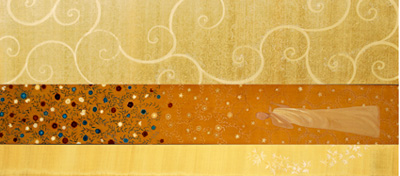
At first glance at the paintings on display at this show, it might appear that figuration remains an abiding thematic of the contemporary art trends in India: a certain attachment to the narrative seems to go hand in hand with the adherence with the flat painterly surface. While more contemporary art forms like the new media and the installation continue to engage artists in India, these are not necessarily associated with the younger artists. In other words, it is the case that the most established artists of India like Vivan Sundaram and Nalini Malani have taken to the installation art form since a couple of decades, the more conventional medium of easel painting refuses to be outmoded. Whether this return to easel painting among the younger artists may be read as market driven or as a sign of any interrogation by these artists of avant garde notions of progress indexed through the embrace of technology is not easy to answer. Rather than being a reflection of the uneven modernity of India, these art works on this show seem to insist upon bold recoding of the medium of painting that asserts its capacity to translate the contemporary experience.
How does one define the contemporary within the constraints of a two dimensional pictorialism? To a western viewer of contemporary art, this might seem to be a contradiction of terms. Cutting across a wide range of styles and modality of representation, the artists at once project somber allegories, vistas of urban detritus, the glaring divides between country and city and the protean presence of global capital though the spectacle of consumption. Too volatile to be captured, artists resort to the game of the fragments to gesture towards the complexity of the world surrounding them.
In fact, the current art scene in India which signals a return to easel painting may invoke the 1980s in Europe and the United States when a similar trend made itself visible. However, the choice largely open to the Euro-American artists then was between reconsidering easel painting or opting for the radical alternatives of Minimalism and Conceptualism. The dialectic between the figurative and the abstract, which underscored modern art in the west, however, seldom informed its counterparts in India. Since mimetic representation was rarely an issue forming the basis of its discourse, the history of modernism in India emerges out of the conflict within the figurative modes of representation themselves. The dividing line between the two was not so much that of historical versus the contemporary frame of reference as that of the choice of the medium So broadly speaking, if the early cultural nationalists declared the medium of oil painting as foreign to Indian sensibility, by the same token, the internationalists like the Bombay Progressives in the 1940s reversed the nationalist arguments and embraced oil painting as an authentic medium.

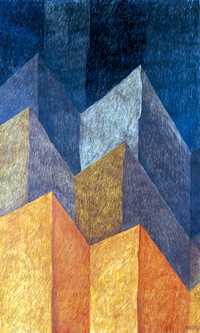
Painterly Pantomimes from western India : Baroda, Ahmedabad and Mumbai
If we take a broad look at the art scene in western India, artists in Ahmedabad and Baroda offer us a distinct picture of the contemporary trends. Apoorva Desai, an artist trained in Baroda but practices in Ahmedabad, has constructed dancing automatons in military camouflage who emblematize instrumental rationality in use in our contemporary global geo-politics whereas a Baroda based artist, Jignasa Ojha painstakingly stages a retake on pop aesthetics which is already hybrid in its lineage from Baroda and London; she situates it within the virtual reality of traveling images that know no national boundaries and plays with scale and history audaciously. If there is any existence of the whole in this ephemeral reality, it exists either in form of the popular imagery manufactured by the mass media as in Rahul Mukherjee’s calendar style rendering of a middle class domesticity; or in the supra-sensible apparitions of mystical transcendence embodied in Poshali Das’s new odes to the “oriental aesthetics” on silk.
But gone are the days of heated confrontations between cultural nationalists and internationalists that centered on the medium or the thematic of invoking or rejecting a mythical past. As if declaring the medium of painting as a never-ending web of representation, it no longer matters if one works in oil, acrylic, tempera or even cloth. Now it is a period of simultaneity- stylistic, formalistic and even political- a co-existence of various kinds of pictorialisms. Pointing in two different directions are the works by K P Reji and Lavanya Mani. If Reji surrenders to the medium of painting, Lavanya defies its conventional logic. Like a Trojan horse, Reji enters into the heart of the medium of painting only to deconstruct its rules of representation, as that of a “still-life” from within as his odd cart loaded with objects, man-made and natural, rolls across our vision. The only relation to painting that Lavanya retains is its frontality. Stitching fragments of cloth on a flat surface, Lavanya revisits childhood tales amidst labyrinth of references to Tarot cards, illustrations from scientific journals, numbers and alphabets. Moving beyond the personal memory are allusions to the cloth in Emperor and His Machine, to the act of stitching in the diagrammatic image of sewing machine in a self referential mode. Quite distinct from the narrative thrust of the young artists, are the garishly painted ‘objects of desire’ by another Baroda artist, Rajmuhammad that blur the lines of distinction between the synthetic and the real and juxtapose, as if in visual puns, sites of plenitude and violence at the same time. In other words, the medium itself performs and embodies the message. Criticality does not reside in the medium per se but its performativity, its ability to play with the rules of representation.

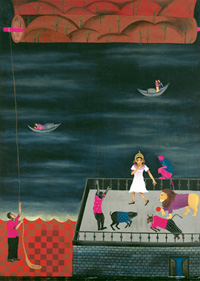
Initially, the idea behind such a show was to incorporate mostly young artists from as many states and regions of India as possible and to identify region-specific trends within the contemporary art scene in India. Such trends are more manifest at the level of institutions which are in turn influenced by major artists associated with them: the persistence of a reworking as well as questioning of the narrative mode of representation via popular visual culture among students trained in Baroda; the Mumbai based artists, particularly with training from the JJ College of art often show predilection for the urban locale: artists from Kalabhavana sport a wide array of stylistics from the gestural to the iconic . On the other hand, the Delhi College of art has over the years produced artists who exult equally in the semi-abstract as in the purely figurative whereas the art school in Hyderabad lays stress on a figurative style with a thrust towards the lyrical and the surreal.
However, what complicates a simple attribution of styles of representation on the basis of institutional affiliation is the mobility of the artists across the states and the institutions. So you have artists from the Baroda art school in New Delhi like Farhad Hussain and M Pravat who either continue to paint in a set style as in the case of the former or let the alienating experience of living in a metro cast a ghostly shadow on the painted desolate interiors.
One of the striking features of this show is that the return to easel painting goes hand in hand with a return to beauty. If modernists like Barnett Newman in the middle of 20th century proclaimed that the impulse of modern art was to destroy beauty , there are a few takers for such a view today. As recent as 1993, Dave Hickey predicted a revival of beauty in the first decade of the 21st century and its resonance are clearly visible in the works of some of the contemporary Indian artists.Some have clubbed aesthetics with new age spiritualism as in the painted silks by Poshali Das or the delicately painted floral “Still Lives” by Rahim Mirza. In the case of the former, the artist reinstates the place of the beautiful within her painstakingly created visages on silk by refashioning dialogues between Rabindranath Tagore’s poems and her forays into the classical art of China and Japan.
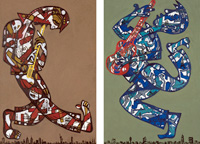

Easel Painting and the Art Scene in Delhi : The National Center and Beyond
The artists who in this exhibition are considered as Delhi artists are in fact a conglomeration of different groups: those who are trained at the Delhi College of art as well as from Baroda, Hyderabad, Kerala, Santiniketan and Bhuvaneshar. It explains the coexistence of a number of styles of art ranging from the most abstract as in works by Pooja Iranna to Benoy Verghese’ photorealism. However, the thrust towards the figurative remains a common thread linking their formally disparate works; Varunika Saraf’s bold juxtaposition of the delicate craftsmanly floral design that frames a self portrait almost staging an existentialist angst; Neeraj Bakshi’s painted masquerades between humans and animals or Shalini Vichitra’s forays into mappings of urban geography and the politics of global surveillance.
Delhi, in this sense, drawing artists from different regions of India, becomes a cultural hub where artists from diverse institutional background jostle together. It is the coexistence of parallel modes of art practice from installation to the mediatic along with the resurgence of easel painting that makes impossible any notion of the national modern.
The mythical-narrative mode, once thought to encapsulate modernism in the third world , seems to flourish more in the works of Indian artists settled abroad: Maya Burman’s intricately woven mythic confabulations of dreaming figures dramatize the journey of ideas and imagination across national boundaries.
If this show brings to the foreground a plurality of styles of representation, where photo realism sits rubs shoulder with an abstract landscape or a visage of popular culture with somber existential dilemmas, it is a reflection of India’s newly proclaimed status as a “transforming” society; which has of late displaced the timeless tag of a “developing” society! While this implies loss in material terms of aid from the first world, it liberates India’s cultural identity from the grip of colonial legacy and places it better to confront its ambivalent future.
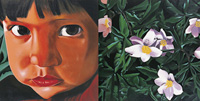

Given the ambitious scope of this exhibition which envisages to bring together young artists from most of the regions of India, a young art critic, Nandini Ghosh from Santiniketan in the east and Giridhar Khasnis from Bangalore in the South have zeroed in on trends manifesting in these regions. Highlighting the contribution of these two regions to contemporary Indian art, sometimes unduly regarded as the cultural hinterland, they have in their own ways touched upon the ties and intersections between the region and the nation, an equation by no means stable and unproblematic. Touching is, for example, the celebration of the integration of the national and the regional on one hand and a formalist reading of various pictorial elements by Khasnis of the artists from the South, on the other. Echoing a dissonant note, Ghosh explores the subtle fissures and cracks behind the aspiration for a culturally integrated nation that takes the form of fragmented narratives and anxious allegories.
Parul Dave Mukherji, New Delhi Towards An Integrated Canvas : A View from the SouthIn the early days of India 's independence, 'Dilli door hai' was a common refrain from different corners of the country. Literally and metaphorically it meant that ' Delhi was far away'. Not only did this impact the political developments of the country, it also had a bearing on socio-cultural and economic aspects. As cities, regions and states got increasingly integrated with the national landscape, the echoes of such complaints became less strident. By the turn of the millennium, the integration was almost complete at national level in many spheres of social and creative endeavor.
Artists from South of India have for decades made a mark on the national scene quite successfully. In fact, the barefoot Badshah of Indian art, M F Husain nurtures strong affiliations with his Sankalana in Bangalore , among others. K K Hebbar, a distinguished artist, born in a coastal district of Karnataka, rose to head the Central Lalit Kala Academi, the apex art institution in the country. J Swaminathan, though bearing a South Indian name, was born and brought up in the North; a well-known figure throughout the country he was not only an artist and activist but also a respected guru. K C S Panniker was another artist-cum-mentor, who inspired the setting up Cholamandalam Artists Village, a fascinating commune for artists near Madras (now Chennai). K G Subramanyan, born in Kerala left for Santiniketan to emerge a distinguished artist, scholar and writer of the country. In the next generation, artists like Yusuf Arakkal, R B Bhaskaran, Adimoolam, S G Vasudev and many others kept up the tempo, with their stimulating solo/group shows, art camps, workshops in different parts of the country and abroad.
Today, one can proudly present the contemporary art scene in the country as a highly integrated one. In particular, students from the South are being trained in prestigious art schools not only in their own home turf but also in Santiniketan ( West Bengal), M S University (Baroda ), J J School of Art (Mumbai) and so on. Simultaneously, both emerging and established artists from other parts of the country have made South India their home, greatly influencing and intensifying the already existing pool of talent in the region.
The artists from South India participating in this show bravely and gracefully hold the proverbial baton passed on by their worthy seniors. Living as they are in challenging times in socio-political and cultural terms, these artists represent a vibrant cross-section of an intricately layered contemporary art canvas. Solid academic grounding and innovative working practices have enabled them to transcend cultural barriers; more importantly, even as they stand rooted in an exclusive local milieu, their vision reaches out to a global horizon. One can discover a unique blend of traditional and modern sensibility in these artists along with an exceptional will to experience, experiment and advance.
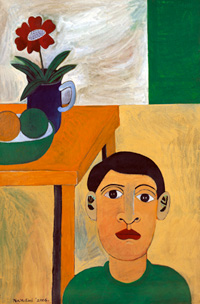
C F John (b.1960) studied Philosophy, before opting for the age-old tradition of Gurukul in arts. His site/theme specific installations, using art, dance and photography have been a cultured responded to political, economic and socially relevant events and occurrences. His earlier paintings were recognized as having several pathways for longer journeys, not essentially visual but physical, while his recent works are pictures of familial bonding, of communion with elements, of prayer for peace and love. Sharing his concern for human association and affection, T M Aziz (b.1962) has partnered with John in several of his projects. His portraits of men, women and children bear only a striking semblance to their real state; although encompassed within a dynamic structure, their presence is almost ethereal. Skirting the borders of illusion and reality, Aziz protects them from excessive decorative elements but nudges them with tender monochromatic tints of uneven stripes and outlines.
On the other hand, Laxman Aelay (b.1964) has an uncanny way of sighting his uncomplicated protagonists in their daily situations. They speak to him with their coy eyes, articulate with rugged postures, communicate through silent expressions, and enliven through sheer physicality and subtle eroticism. A perfect sense of timing brings life to Laxman's mischievous lines; his paintings resemble pages snatched from an anonymous if contemporary folk tale. Quite distinct are Murali Cheroth's men in uniform . Highly conscious of and resplendent in their sharply illuminated naval dress, appearance and gait, they show their implicit power, veiled prowess and clear identity. Murali's works sight these men in shimmering light of a commercial street – isolated, enigmatic, and in a strange way, attractive.
For B Devaraj (b. 1966) the distinction between man and animal is often very thin. Man being an inherently aggressive animal is a thought that swamps several of his canvases. In his work, a tiger strolls across a wasteland in the same way a nomad would; it rests on a wooden bench like a tired trekker; it gives out a full-throated cry emerging from the body of a kneeling man…These are images of suspense and drama.
In a similar vein, for Gouri Vemula (b. 1972) the goat emerges as a leitmotif. With stiff horns and wavy beards, her goats are not gentle, domesticated animals but agile and energetic. Making long flying leaps, they seem to be fighting for their freedom from entanglement with each other and with elements.
In K Ravi's works, one finds a childlike quality. The human figure is his prime motif. Particularly enchanted with the feminine form, he draws them from his memory of an early childhood spent in the villages. On the other hand, Shibu Arakkal (b. 1976), already well known for his monochromatic semi-abstract and abstract photographic images, weaves his images of refined intimacy with elegantly meandering lines, architectural assemblages and mirrored montages. His inspirations are self-confessedly eclectic; accordingly his works cannot be branded to have belonged to any particular genre.
These artists stand out as a unified chorus in a pleasing symphony. They, along with many others, form the core of the creative canvas stretching across an emergent India.
Giridhar Khasnis, Bangalore Voices of Dissonance from the East : Santiniketan and KolkataIn the early days of India 's independence, 'Dilli door hai' was a common refrain from different corners of the country. Literally and metaphorically it meant that ' Delhi was far away'. Not only did this impact the political developments of the country, it also had a bearing on socio-cultural and economic aspects. As cities, regions and states got increasingly integrated with the national landscape, the echoes of such complaints became less strident. By the turn of the millennium, the integration was almost complete at national level in many spheres of social and creative endeavor.
Production of art-objects is a form of ‘culturalism’, constructing social meanings and establishing identities through “the terrain of the ‘lived’”, at times appearing in the guise of contradictions.
For India, despite a dominant polemic of the “national”, specificities of the regional hold possibilities for a more culturally contextual study. Eastern India, once evolving around the art schools of Kolkata and Santiniketan, is in a process of perpetual transformation wherein the regional and the national stand against each other in an endless contestation. Compounding an already existing fraught equation between the local and the national is the entry of globalization. Under the present regime of the communist party, globalization poses itself as a Janus faced formation- a form of neo-colonialism yet projected as an economic necessity by the state. Such a state of affairs tends to push the individual producers of cultural objects into a dilemma of acquiescence or resistance. At times, the regional tends to lose its verve and merge into the national (or the global), whereas at other times it attempts to reinforce its threatened self-identity. At another level, the regional, moving out of an exclusive geographical determination, extends to refer to an individual’s (gendered) self identity — the local construed as the intensely personal, pitted against all else.
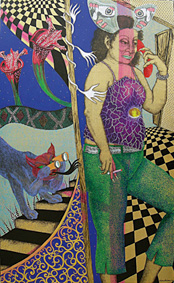
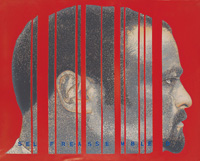
Amongst the various trajectories, one represents an aspiration for belonging to “contemporary” linguistic modes in form of photo-realism and digital imagery. Pampa Panwar and Prasanta Sahu speak in two different kinds of such currently global languages. Pampa reflects upon her ambient existence, Santiniketan, situated amidst the bounty of nature, away from the metropolis — the feel of the changing seasons — their colours — experiences that one’s sensory perception would cherish, accentuated by the pristine purity of a rural setting.
Emphasizing on the primary shades, Prasanta’s images are based on a notion of the “real”, customarily presumed in photographed portraits. At times his engrossment with the self nearly extends to the ‘body’ — as if peeling off the skin — a process of fragmentation and de-fragmentation of the self-image, dissolving into and emerging from the elementary world. Thereby, despite an apparent objectivity, Prasanta’s paintings emote a shade of pain, deep-rooted and self-inflicted.
Refusing to align himself with the global art trends, Jayanta Mondal evokes a romantic world, a discovery and rediscovery amidst nature — trees, forests, as well as cityscapes. What he cherishes amongst both the natural and the man-made environment is the element of the ephemeral, which became intensified following his visit to China- not the present day China but of the classical period.

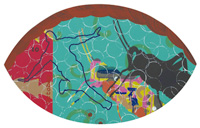
An intense homemaker, Manjari Chakraborty’s forms and expressions evolve out of a domestic context that she celebrates on the canvas. In an earlier format, Manjari’s canvases were peopled with multiple imagery, beings and objects of daily acquaintance, presented in their neatly allocated spaces. In her more recent exercises, Manjari has moved a step towards a mode of abstraction and drawn towards the script as patterns.
Celebrating her womanhood, Chandrima Bhattacharya moves from her earlier adherence to domestic spaces, peopled with cats, children, and so on to a symbolic and allegorical punning where she explores the experiences of middle age femininity via a fictive world. Challenging the received notion of subordination of embroidery as craft, Rima stitches up flowery patterns on the surface and lend it a lyrical touch through poignant and playful titles. Trained as a printmaker, she has turned to multi-media with extreme sensitiveness towards the interplay between the figure and the ground and the delicate texture of the surface. On the other hand, Somnath Maity’s imagery represents a conflict between the rural and the urban by painting most evocative and haunting urban landscapes that waver between a romantic nostalgia and the reality of urban detritus. Taking off on a more abstract level are meta-landscapes by Samit Das who derives his inspiration from photography- that both allows him to document as well as conjure up abstract patterns out of the skeletal, the dilapidated, and the worn out as the imagery of the urban squalor.
Along a more ludic note are works by Sahajahan that stage man-woman relationships, deploying stark contrasts in colour, through a language that is both modernist a la Ferdinand Leger and the folk style of rural Bengal. Just as his intertwining figures play a hide and seek, so do his titles like “It’s better to close your eyes” addressing the viewer upfront.
Patha Shaw calls his semi-abstract geometric forms “mental landscape”- images that bridge the abstract and the real. Supposedly universal in their appeal, they do not seem to represent a concern or clash between the local, the national or the all-encompassing global.

Impossible to encompass the whole spectrum of contemporary art trends in the eastern regions via a handful of artists, this assortment of works offer more of a fragmentary picture of the region. Gesturing towards the complex dynamics across the regional, the national and the global, they chart an uneasy terrain of cultural transactions against the background of uneven modernity.
Nandini Ghosh, Kolkata(From the catalogue of the show ‘Emerging India’, organised by Art Alive Gallery at The Henry Moore Gallery, Royal College of Art in August–September, 2007 as part of ‘India Now’ festival organised by the Mayor of London).

